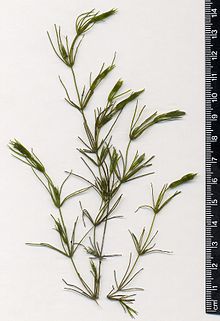- Chara (alga)
-
Chara 
Chara globularis Scientific classification Kingdom: Plantae Division: Charophyta Class: Charophyceae Order: Charales Family: Characeae Genus: Chara
L., 1753Species See text
Chara is a genus of green algae in the family Characeae.
Contents
Structure
Chara species are multicellular and superficially resemble land plants because of stem-like and leaf-like structures. The branching system is complex with branches derived from apical cells which cut off segments at the base to form nodal and internodal cells alternately. They are typically anchored to the littoral substrate by means of branching underground rhizoids. Chara plants are rough to the touch because of deposited calcium salts on the cell wall. The metabolic processes associated with this deposition often give Chara plants a distinctive and unpleasant smell of hydrogen sulfide.[1]
Morphology
The plant body is a gametophyte. It consists of a main axis (differentiated into nodes and internodes), dimorphic branches (long brach of unlimited growth and short branches of limited growth), rhizoids (multicellular with oblique septa) and stipulodes (needle shaped structures at the base of secondary laterals.
Occurrence
Species are found in fresh water, particularly in limestone areas throughout the northern temperate zone. They prefer less oxygenated and hard water and are not found in the waters where mosquito larvae are present. Chara grow submerged attached to the muddy bottom of the pools and ponds of clear water. They are covered with calcium carbonate deposits.
Reproduction
Chara reproduces vegetatively and sexually. Vegetative reproduction takes place by tubers, amylum stars and secondary protonema. The fructifications for sexual reproduction are globule or antheridium (male) and nucule or archegonium (female).
Species
- Chara braunii (ITIS)
- Chara canescens (ITIS)
- Chara contraria (ITIS) opposite stonewort
- Chara corallina (ITIS)
- Chara elegans (ITIS)
- Chara excelsa (ITIS)
- Chara fibrosa (ITIS)
- Chara formosa (ITIS)
- Chara fragilis (ITIS)
- Chara globularis (ITIS)
- Chara hispida (ITIS)
- Chara hornemannii (ITIS)
- Chara intermedia (ITIS)
- Chara nataklys
- Chara sejuncta (ITIS)
- Chara virgata (ITIS)
- Chara vulgaris (ITIS)
- Chara zeylanica (ITIS)
- Chara connivens (convergent stonewort)
Distribution
Found in the Eglinton Canal, Galway, Ireland:- Chara virgata.[2] Chara rudis.[2]
References
References
Categories:- Green algae
- Algae stubs
Wikimedia Foundation. 2010.
